
South is to your right, North to the left. Churches faced east toward Jerusalem so the church is oriented in that direction.
You enter the church via one the three double wooden doors which are recessed in the triploid Romanesque style. Directly inside the front doors is the narthex which has a slate floor. The Narthex is the vestibule of the church, a place to greet parishioners, a place of gathering of both people and collection of donations. We have a tract rack with current information as well as a register for visitors and donation boxes.
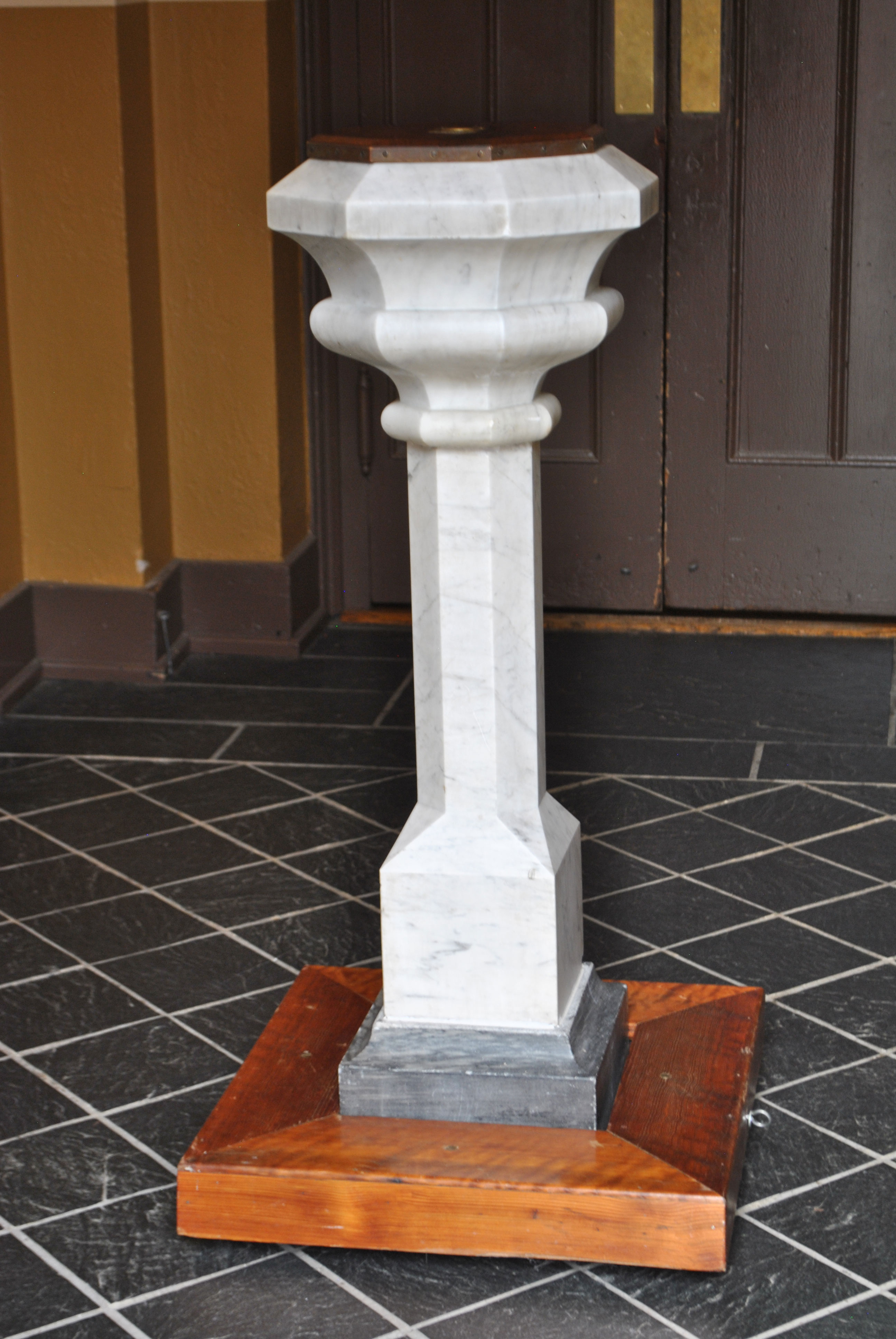
The church has a font given by Basil Gordon in 1829. It can be in the Narthex or closer to the front when we have a baptism.
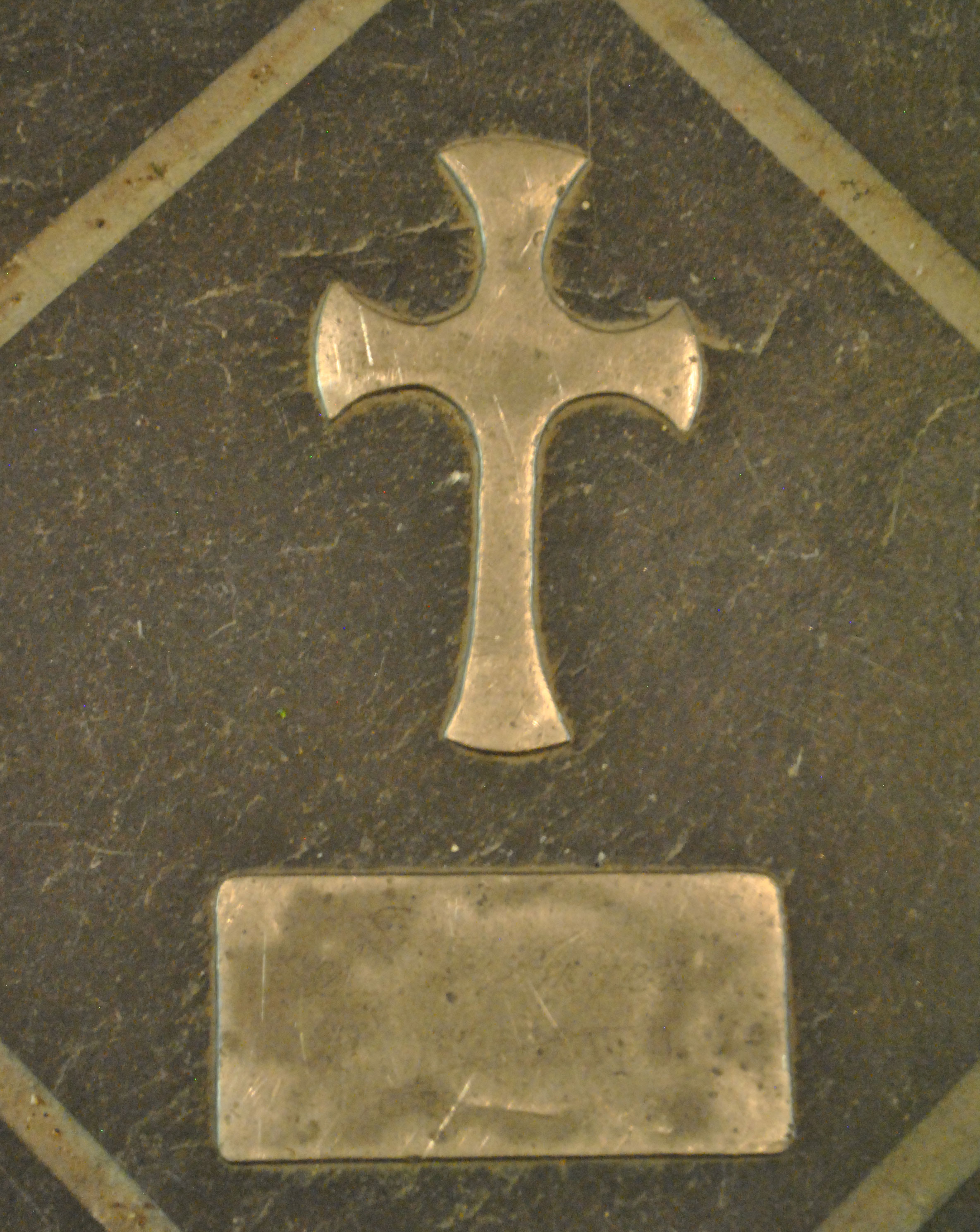
In the middle of the floor is Brass Maltese Cross Plaque inlaid in the slate floor in Chancel in loving memory Nannie S. Goodwin Erected By The Guild Ascension Day, 1925 In Appreciation of Her Many Years of Faithful and Loving Service

In the north and the south ends of the narthex are the typical rounded , recessed arches which divide the narthex into three sections. In each of the two side sections is a stairway which ascends to the gallery. The Romans were the first builders in Europe, perhaps the first in the world, fully to appreciate the advantages of the arch, the vault and the dome. The use of Romanesque Revival in St. George’s is primarily seen in the arches.
In the south end of the nave the stairway descends to the undercroft area of the church.
On both the north and south sides, there are steps on either side of the Narthex that are original with black walnut railings which lead to the gallery above. See below

Narthex Wall

The Narthex wall reflects the decorative paint added during our renovation 2007-2010. The renovation relied heavily on a 1906 picture taken during a renovation of that year (above)
The decorative paint design in the Narthex front mirrors that found in a 1906 picture. The detail in the 1906 picture is between the reredos and the center window . The iconography was significant in the 19th century and this small details remembers that period.
Details of the 1906 picture
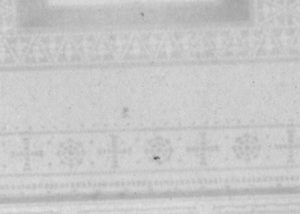

Current pattern in the Narthex
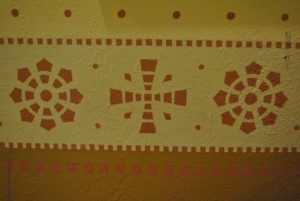
Plaques
Our church has several historical plaques. Several are in the Narthex:
1 George Hume
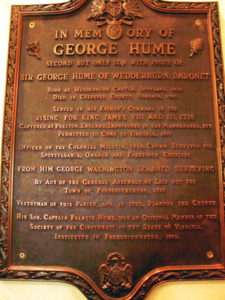
The plaque was placed here in May, 1938 by Col. Erskine Hume, a direct descendant and who served in three wars. The dedication was June 26, 1938.
As with many people in St George’s early 18th century history, Hume was not a native. Born in 1698 at Wedderburn Castle in Scotland, the family home for 600 years, Hume came here by accident. He served under the command of his father in 1715 in the losing cause to support James III (called the “Old Pretender”) son of the deposed king James II of England in his effort to claim the throne of England, Scotland and Ireland.
Captured and imprisoned, Hume served two years in prison. When he was released there were few opportunities open for a convict and a second son. An additional problem was that he was out of favor with his brother-in-law Rev. Ninian Hume who was reorganizing the family property. Hume was permitted to come to Virginia in 1721 as an indentured labor which was a break for him after prison.
Shortly after arriving, he went to Williamsburg to be under the care of a doctor who was another Scottish exile. He also had relatives in high places as his cousin Alexander Spotswood was governor of Virginia who had freed his uncle Francis Hume, but by the time Hume recovered Spotswood was out of office. George had studied mathematics in Scotland, and so while in Williamsburg was sent to the College of William and Mary and was accredited by it as a
surveyor.
By 1725 he moved to the new county of Spotsylvania. On August 13, 1728, George made the first survey of Fredericksburg when he laid out the 64 original lots from 50 acres. With a marriage dower of 2000 lands in marriage to Elizabeth Proctor, he took up residence here to market his profession. Hume became a member of our Vestry in 1729 having served as a reader in another church. Our Vestry minutes report that along with Benjamin Cave he was appointed to count tobacco plants. Despite serving against the English, he was commissioned a lieutenant in the colonial militia, possibly because they needed able bodied men to handle disputes with the Indians.
Hume was hired in June, 1733 to “set the Church in Fredericksburg East and West” as required by Anglican Law and received 100 pounds of tobacco as his payment. This is our first building which we date from 1735 when we paid the sexton. In October 1735, Hume recorded a deed to a 929 acre Spotsylvania County property division near Fredericksburg. This particular division helped form the framework for many of Fredericksburg’s 19th century
neighborhoods.
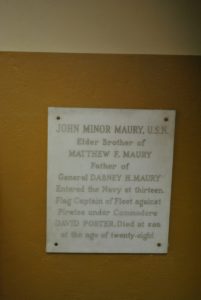
2. John Minor Maury
John Minor Maury (“JM”) was eclipsed by his famous younger brother Matthew Fontaine Maury, the “pathfinder of the seas” and professor and his son General Dabney Maury. Dabney Maury who commanded a division during the Civil War went on to write his memoirs about that war and others. He also was a minister to
Colombia and founded the Southern Historical Society.
“JM” has a good reason why his name engenders obscurity – he died early in life in his 28th year. His connection with St. George’s is also
somewhat tenuous. His family was well known here, however. His grandfather Rev. James Maury (1719-1760) was a rector at St. George’s and also educator to famous pupils, such as George Washington and Thomas Jefferson who lived with Rev James Maury’s family for two years while he was being educated. One of Rev Maury’s thirteen children was Fontaine Maury (born 1761). Fontaine was a pew holder in 1789, a trustee in 1793, vestryman and warden who served on the vestry through 1799. One of his duties was to obtain “subscriptions” or pledges which were not only from individuals but also from the town of Fredericksburg.
The Maury family left Fredericksburg in 1811 to move to Franklin, Ten. or when JM was 16 . By that time JM had been sailing since 1808 and had already been appointed a midshipman in the navy in 1809 and commissioned in 1811. JM was inspiring to younger brother Matthew. Maury’s letters of his adventures in the navy that were sent home were considered to be a major reason why Matthew Maury decided on a naval career much to the chagrin of his father. “JM” married a first cousin Eliza Herndon Maury, daughter of Elizabeth Brooke and Fontaine Maury.
One of the adventures that inspired his brother was his sailing to China under a Captain William Lewis as a first officer. This was a trading voyage but while there they had obtained furloughs. Maury, with six men, was left on the island of Nokaheeva to collect sandal-wood and other valuable articles of trade against the return of the ship. The War of 1812 broke out, and Captain Lewis was blockaded in a Chinese port. To make matters worse, Maury and his
men were beset by the natives of one part of the island who were fighting a civil war against another group. All of the party except Maury and another sailor were killed. These two constructed a place of refuge in the tops of four cocoanut trees which grew close enough together and provided a safe haven from the natives. The Essex under David Porter later saved them possibly due to the recognition of Maury by one of the shipmates. Porter had captured another ship which he renamed Essex Jr and Maury became its first lieutenant.
Maury later served on the War of 1812 under Command Thomas McDonough in the victory of the Battle Lake Champlain which decimated the British fleet there. He wrote to a friend in Fredericksburg, “We have gained a glorious victory. I hope the most important result of it will be to confirm the wavering allegiance of New York and Vermont to the Union. They have been threatening to secede unless peace be made with England on any terms!”
One of the unique episodes in the early American republic was the dealings with pirates, those closer to Africa, the Barbary pirates and those nearer in the West Indies. Captain David Porter was ordered to fit out a squadron for their destruction. He was authorized to select his officers for this dangerous mission. His first choice was Lieutenant John M. Minor to be flag captain of the fleet. This officer, like the adjutant general of the army, gave orders for all the movements. The service was active and severe; the combats were desperate; no quarter was asked or given. The pirates were all destroyed or broken up and scattered.
As a demonstration of Maury’s services, he was sent by Porter to report to the US government of the success of the mission. However, he died of yellow fever just outside Norfolk and buried at sea. Throughout his short career, Maury had gained the respect of his peers. His brother wrote that at “the time of his death he was the highest ranking officer of his age in the service.”
Dabney Herndon, the cashier of the Farmer’s Bank (just across from St. George’s) took Maury’s widow and her two sons to his home, where they lived until his death. Maury’s oldest son had already died in childhood and is buried at the Masonic Cemetery. JM’s famous brother Matthew Fontaine Maury later married Herndon’s eldest daughter, Ann. One of Dabney Herndon’s cousins was Ellen Herndon who later married future president Chester Arthur.
